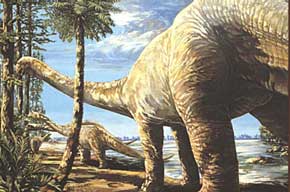Texas state dinosaur; Image from Texas Parks and Wildlife* by artist G. Aaron Morris (used by permission).
Official State Dinosaur of Texas
Texas designated Brachiosaur sauropod, Pleurocoelus as the official state dinosaur in 1997. But in 2007, paleontologists re-identified the bones and footprints as Paluxysaurus Jonesi. The dinosaur is named for the town of Paluxy in Hood County and for the Paluxy River, both of which are near the Jones Ranch site where the fossils of this species were discovered.
In 2009 a resolution was passed to amend the name of the Lone Star state dinosaur to Paluxysaurus Jonesi. it is estimated that this dinosaur measured 70 feet long and 12 feet high at the shoulder, and weighed as much as 20 tons. All State Dinosaurs
* Dinosaur image was copied on 12/08/04 from Texas Parks & Wildlife Department's Web Site: www.tpwd.state.tx.us. Neither this website, nor the information presented on this website, is endorsed by the State of Texas or Texas Parks and Wildlife Department.

